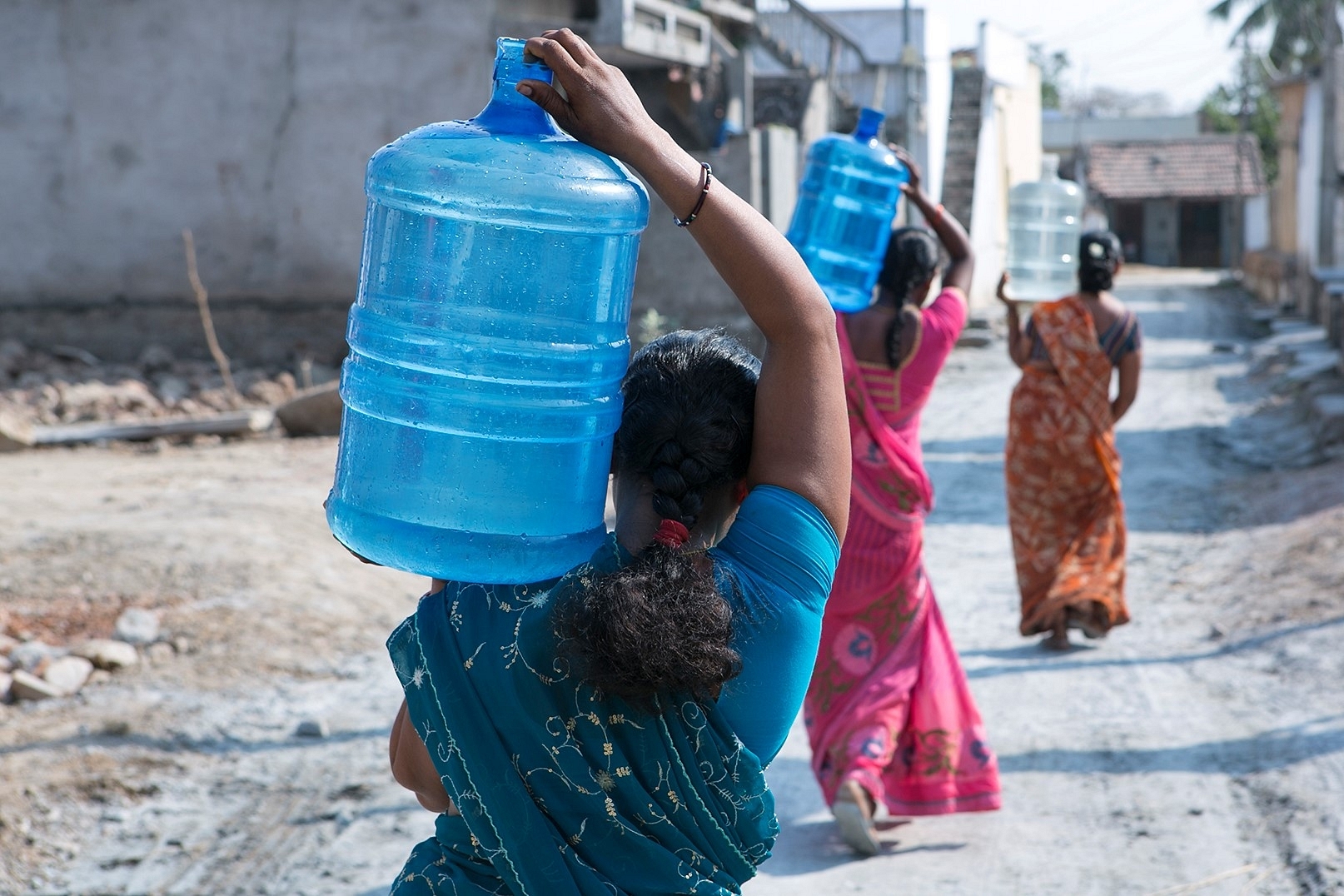News Brief
Big Move To Digitise Water Supply Infrastructure Across Rural India
- The National Jal Jeevan Mission in partnership with State Governments and sector partners has started facilitating sensor-based water supply system on pilot basis in several villages.
- The data from 11 pilot locations about the daily water supply quantity and regularity are shown on the Jal Jeevan Mission dashboard.

Women fetching water from a reverse osmosis plant at Jangalapalli village in Andhra Pradesh’s Guntur district.
In a major initiative to digitise water supply infrastructure in rural India, National Jal Jeevan Mission has reached out to all States/ UTs for rolling out of sensor-based IoT solutions to measure and monitor water supply in the hinterland.
The initiative aims at ensuring water service delivery in rural homes by addressing various issues that cause disruption in water supply on regular basis.
Digitally enabled water supply infrastructure will help in near real-time monitoring and evidence-based policy making. Digitisation of water supply infrastructure has the potential to help the Gram Panchayats.
More importantly, it will help anticipate and address future challenges.
India has one of the most vibrant IoT eco-systems in the world, with various supporting enablers making it conducive for companies seeking to serve the global demand beyond national boundaries.
The government has introduced a number of initiatives to leverage the benefits of these disruptive IoT technologies in multiple sectors.
In order to utilise this expertise, the National Jal Jeevan Mission (NJJM) of the Jal Shakti Ministry has constituted a Technical Expert Committee to prepare a road map for measurement and monitoring of water service delivery system in the rural areas.
The committee has eminent members from academia, administration, technology and specialists from the water supply sector. The committee met 11 times and despite the Covid pandemic finalised the report.
The report, which has been shared with the States/UTs, provides a framework to design, develop and establish a coherent system that is able to exchange data at the local and central levels. The broad framework will help the States/ UTs in firming up the desired standards to meet the requirements of change from mere infrastructure to ensuing water service delivery.
The mission in partnership with State Governments and sector partners has started facilitating sensor-based water supply system on pilot basis in several villages. The data from 11 pilot locations about the daily water supply quantity and regularity are shown on the Jal Jeevan Mission dashboard.
Many States like Bihar, Punjab, and Haryana have come forward for its implementation. Sikkim, Manipur, and Goa have completed basic survey works. Gujarat has begun navigating the sensor-based rural water supply systems in 1,000 villages.
A technology grand challenge launched by NJJM in partnership with Ministry of Electronics and Communication, Government of India, is going to be showcased in 100 villages in the States of Uttar Pradesh, Haryana, Rajasthan, Gujarat, Andhra Pradesh, Karnataka and Manipur.
The data collected from the field locations will be transmitted to the State and Central servers and can be used to monitor the functionality (quantity, quality and regularity of water supply) at the State and Central levels.
This will ensure minimised service delivery outage and water loss and will monitor the quantity and quality on a long-term basis. The additional advantage of this data would be to analyse the demand pattern of the user groups over time and use this information for demand management at the aggregate level. It will also help minimise non-revenue water, and ensure proper management and effective operation and maintenance of water supply systems in the villages.
In accordance with the 73rd amendment to the Constitution, Gram Panchayats or their sub-committee — Village water & Sanitation Committee/Pani Samiti — will play a key role in managing drinking water supply in rural areas.
As per the conditions of the 15th Finance Commission grants to utilise for drinking water and sanitation, States and Gram Panchayats or Pani Samitis, an automated system for measurement and monitoring of water supply is necessary.
This requires the use of modern technology for measurement and monitoring of the water service delivery and to capture and transmit service delivery data automatically for ensuring the quality of service.
Better Internet Connectivity
It’s also the endeavour of the Union government to expand the optic fibre network up to all villages. Accordingly, the Prime Minister announced that all villages will be connected by fibre optic network.
In almost the whole country, telecom connectivity has reached. IoT strategies are increasingly used to monitor the water quantity and quality. Recent technological advancements such as IoT, Big Data Analytics, Cloud, etc. and declining costs of mobile data, hardware (sensors), and software provide an opportunity to digitise water supply infrastructure in rural India.
Jal Jeevan Mission, the Union government’s flagship programme, focuses on water service delivery at the household level of prescribed quality on a regular and long-term basis.
Under the Mission, Gram Panchayats are required to function as a ‘local public utility’ for drinking water management, water service delivery, grey water treatment and reuse, operation and maintenance of in-village water supply infrastructure.
Support Swarajya's 50 Ground Reports Project & Sponsor A Story
Every general election Swarajya does a 50 ground reports project.
Aimed only at serious readers and those who appreciate the nuances of political undercurrents, the project provides a sense of India's electoral landscape. As you know, these reports are produced after considerable investment of travel, time and effort on the ground.
This time too we've kicked off the project in style and have covered over 30 constituencies already. If you're someone who appreciates such work and have enjoyed our coverage please consider sponsoring a ground report for just Rs 2999 to Rs 19,999 - it goes a long way in helping us produce more quality reportage.
You can also back this project by becoming a subscriber for as little as Rs 999 - so do click on this links and choose a plan that suits you and back us.
Click below to contribute.
Latest